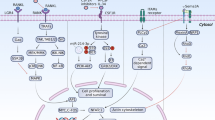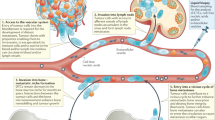Abstract
Bone resorption by osteoclasts is thought to promote the proliferation of prostate cancer cells disseminated to the skeleton (Mundy, 2002). Using a mouse model of experimental metastasis, we found that although late-stage metastatic tumors were indeed surrounded by osteoclasts, these cells were spatially unrelated to the small foci of cancer cells in early-stage metastases. This is the first evidence that survival and growth of disseminated prostate cancer cells immediately after their extravasation may not depend on osteoclast involvement. Interestingly, prostate cancer cells expressing the α-receptor for platelet-derived growth factor (PDGFRα) progress during early-stages of skeletal dissemination, whereas cells expressing lower levels or lacking this receptor fail to survive after extravasation in the bone marrow. However, non-metastatic cells acquire bone-metastatic potential upon ectopic overexpression of PDGFRα. Finally, functional blockade of human PDGFRα on prostate cancer cells utilizing a novel humanized monoclonal antibody—soon to undergo phase-II clinical trials—significantly impairs the establishment of early skeletal metastases. In conclusion, our results strongly implicate PDGFRα in prostate cancer bone tropism through its promotion of survival and progression of early-metastatic foci, providing ground for therapeutic strategies aimed at preventing or containing the initial progression of skeletal metastases in patients affected by prostate adenocarcinoma.
This is a preview of subscription content, access via your institution
Access options
Subscribe to this journal
Receive 50 print issues and online access
$259.00 per year
only $5.18 per issue
Buy this article
- Purchase on Springer Link
- Instant access to full article PDF
Prices may be subject to local taxes which are calculated during checkout





Similar content being viewed by others
References
Andrae J, Gallini R, Betsholtz C . (2008). Role of platelet-derived growth factors in physiology and medicine. Genes Dev 22: 1276–1312.
Bajaj GK, Zhang Z, Garrett-Mayer E, Drew R, Sinibaldi V, Pili R et al. (2007). Phase II study of imatinib mesylate in patients with prostate cancer with evidence of biochemical relapse after definitive radical retropubic prostatectomy or radiotherapy. Urology 69: 526–531.
Betsholtz C . (2004). Insight into the physiological functions of PDGF through genetic studies in mice. Cytokine Growth Factor Rev 15: 215–228.
Canon JR, Roudier M, Bryant R, Morony S, Stolina M, Kostenuik PJ et al. (2008). Inhibition of RANKL blocks skeletal tumor progression and improves survival in a mouse model of breast cancer bone metastasis. Clin Exp Metastasis 25: 119–129.
Carnero A, Blanco-Aparicio C, Renner O, Link W, Leal JF . (2008). The PTEN/PI3K/AKT signalling pathway in cancer, therapeutic implications. Curr Cancer Drug Targets 8: 187–198.
Chambers AF, Groom AC, MacDonald IC . (2002). Dissemination and growth of cancer cells in metastatic sites. Nat Rev Cancer 2: 563–572.
Dolloff NG, Russell MR, Loizos N, Fatatis A . (2007). Human bone marrow activates the Akt pathway in metastatic prostate cells through transactivation of the alpha-platelet-derived growth factor receptor. Cancer Res 67: 555–562.
Dolloff NG, Shulby SS, Nelson AV, Stearns ME, Johannes GJ, Thomas JD et al. (2005). Bone-metastatic potential of human prostate cancer cells correlates with Akt/PKB activation by alpha platelet-derived growth factor receptor. Oncogene 24: 6848–6854.
Fidler IJ . (2003). The pathogenesis of cancer metastasis: the ‘seed and soil’ hypothesis revisited. Nat Rev Cancer 3: 453–458.
Fritz V, Louis-Plence P, Apparailly F, Noël D, Voide R, Pillon A et al. (2007). Micro-CT combined with bioluminescence imaging: a dynamic approach to detect early tumor-bone interaction in a tumor osteolysis murine model. Bone 40: 1032–1040.
Gupta GP, Ngyuen DX, Chiang AC, Bos PD, Kim JY, Nadal C et al. (2007). Mediators of vascular remodeling co-opted for sequential steps in lung metastasis. Nature 446: 765–770.
Heldin C-H, Westermark B . (1999). Mechanism of action and in vivo role of platelet-derived growth factor. Physiol Rev 79: 1283–1316.
Jamieson WL, Shimizu S, D’Ambrosio JA, Meucci O, Fatatis A . (2008). CX3CR1 is expressed by prostate epithelial cells and androgens regulate the levels of CX3CL1/fractalkine in the bone marrow: potential role in prostate cancer bone tropism. Cancer Res 68: 1715–1722.
Kingsley LA, Fournier PG, Chirgwin JM, Guise TA . (2007). Molecular biology of bone metastasis. Mol Cancer Ther 10: 2609–2617.
Lee YP, Schwarz EM, Davies M, Jo M, Gates J, Shang X et al. (2002). Use of zoledronate to treat osteoblastic versus osteolytic lesions in a severe-combined-immunodeficient mouse model. Cancer Res 62: 5564–5570.
Lin AM, Rini BI, Weinberg V, Fong K, Ryan CJ, Rosenberg JE et al. (2006). A phase II trial of imatinib mesylate in patients with biochemical relapse of prostate cancer after definitive local therapy. BJU Int 98: 763–769.
Loizos N, Xu Y, Huber J, Liu M, Lu D, Finnerty B et al. (2005). Targeting the platelet-derived growth factor receptor α with a neutralizing human monoclonal antibody that inhibits the growth of tumor xenografts: implications as a potential therapeutic target. Mol Cancer Ther 4: 369–379.
Mathew P, Thall PF, Bucana CD, Oh WK, Morris MJ, Jones DM et al. (2007). Platelet-derived growth factor receptor inhibition and chemotherapy for castration-resistant prostate cancer with bone metastases. Clin Cancer Res 13: 5816–5824.
Mathew P, Thall PF, Jones D, Perez C, Bucana C, Troncoso P et al. (2004). Platelet-derived growth factor receptor inhibitor imatinib mesylate and docetaxel: a modular phase I trial in androgen-independent prostate cancer. J Clin Oncol 22: 3323–3329.
Mundy GR . (2002). Metastasis to bone: causes, consequences and therapeutic opportunities. Nat Rev Cancer 2: 584–593.
Nemeth JA, Harb JF, Barroso Jr U, He Z, Grignon DJ, Cher ML . (1999). Severe combined immunodeficient-hu model of human prostate cancer metastasis to human bone. Cancer Res 59: 1987–1993.
Paget S . (1889). The distribution of secondary growths in cancer of the breast. Lancet 1: 571–573.
Rao K, Goodin S, Levitt MJ, Dave N, Shih WJ, Lin Y et al. (2005). A phase II trial of imatinib mesylate in patients with prostate specific antigen progression after local therapy for prostate cancer. Prostate 62: 115–122.
Roodman GD . (2004). Mechanisms of bone metastasis. N Engl J Med 350: 1655–1664.
Ross RW, Oh WK, Hurwitz M, D’Amico AV, Richie JP, Kantoff PW . (2006). Neoplasm of the prostate. In: Holland-Frei (ed). Cancer Medicine. BC Decker Inc. publisher, pp 1431–1461.
Schneider A, Kalikin LM, Mattos AC, Keller ET, Allen MJ, Pienta KJ et al. (2005). Bone turnover mediates preferential localization of prostate cancer in the skeleton. Endocrinology 146: 1727–1736.
Shulby SA, Dolloff NG, Stearns ME, Meucci O, Fatatis A . (2004). CX3CR1-fractalkine expression regulates cellular mechanisms involved in adhesion, migration, and survival of human prostate cancer cells. Cancer Res 64: 4693–4698.
Thorarinsdottir HK, Santi M, McCarter R, Rushing EJ, Cornelison R, Jales A et al. (2008). Protein expression of platelet-derived growth factor receptor correlates with malignant histology and PTEN with survival in childhood gliomas. Clin Cancer Res 14: 3386–3394.
van der Pluijm G, Que I, Sijmons B, Buijs JT, Lowik CW, Wetterwald A et al. (2005). Interference with the microenvironmental support impairs the de novo formation of bone metastases in vivo. Cancer Res 65: 7682–7690.
Vantyghem SA, Allan AL, Postenka CO, Al-Katib W, Keeney M, Tuck AB et al. (2005). A new model for lymphatic metastasis: development of a variant of the MDA-MB-468 human breast cancer cell line that aggressively metastasizes to lymph nodes. Clin Exp Metastasis 22: 351–361.
Wang M, Stearns ME . (1991). Isolation and characterization of PC-3 human-prostatic tumor sublines which preferentially metastasize to select organs in SCID mice. Differentiation 48: 115–125.
Wetterwald A, van der Pluijm G, Que I, Sijmons B, Buijs J, Karperien M et al. (2002). Optical imaging of cancer metastasis to bone marrow: a mouse model of minimal residual disease. Am J Pathol 160: 1143–1153.
Yarden Y, Escobedo JA, Kuang WJ, Yang-Feng TL, Daniel TO, Tremble PM et al. (1986). Structure of the receptor for platelet-derived growth factor helps define a family of closely related growth factor receptors. Nature 323: 226–232.
Acknowledgements
The cDNA for human PDGFRα was a kind gift of Dr Carl-Henrik Heldin (Ludwig Institute for Cancer Research, Uppsala, Sweden). We thank Dr Olimpia Meucci (Department of Pharmacology and Physiology) for critically reading the manuscript and helpful discussion, Dr Mark Stearns (Department of Pathology and Laboratory Medicine) for helpful discussion, Dr Gregg Johannes (Department of Pathology and Laboratory Medicine) for help with the PDGFRα-expressing vector, Mr Michael Amatangelo for his contribution to the immuno-detection of PDGFRα in human tissues and Dr Nick Loizos (ImClone Systems Inc., New York, NY, USA) for kindly providing the IMC-3G3 antibody. This study was supported in part by the NIH Grant GM067892 to AF.
Author information
Authors and Affiliations
Corresponding author
Additional information
Supplementary Information accompanies the paper on the Oncogene website (http://www.nature.com/onc)
Supplementary information
Rights and permissions
About this article
Cite this article
Russell, M., Jamieson, W., Dolloff, N. et al. The α-receptor for platelet-derived growth factor as a target for antibody-mediated inhibition of skeletal metastases from prostate cancer cells. Oncogene 28, 412–421 (2009). https://doi.org/10.1038/onc.2008.390
Received:
Revised:
Accepted:
Published:
Issue Date:
DOI: https://doi.org/10.1038/onc.2008.390
Keywords
This article is cited by
-
Cooperation among heterogeneous prostate cancer cells in the bone metastatic niche
Oncogene (2017)
-
Immunohistochemical expression of PDGFR, VEGF-C, and proteins of the mToR pathway before and after androgen deprivation therapy in prostate carcinoma: significant decrease after treatment
Targeted Oncology (2014)
-
A phase I study of olaratumab, an anti-platelet-derived growth factor receptor alpha (PDGFRα) monoclonal antibody, in patients with advanced solid tumors
Cancer Chemotherapy and Pharmacology (2014)
-
The chemokine receptor CX3CR1 is directly involved in the arrest of breast cancer cells to the skeleton
Breast Cancer Research (2011)



